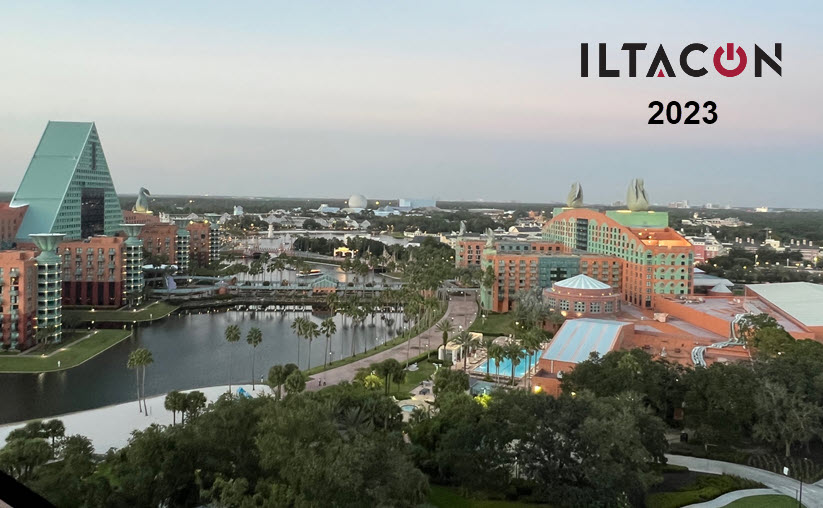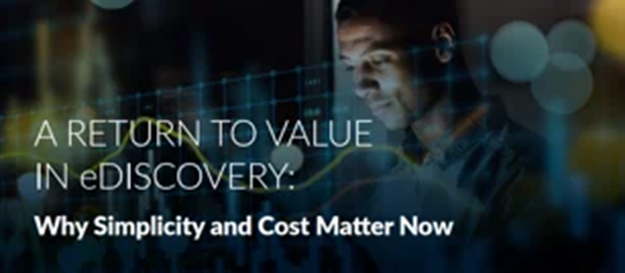By Catherine Ostheimer
This year’s ILTACON, held at the Walt Disney World (WDW) hotel properties in Orlando covering a 430,000+ square foot campus, was a spectacular event on many levels. For one, seemingly few of the 3,400 attendees complained about the long walks in 90-degree heat required to attend educational sessions and meetings. Energy ran high throughout the conference despite the heat and expansive conference grounds. Secondly, the interest in emerging tech like Generative AI, automation, and short message data eDiscovery solutions has gone from “what is it,” to “how to apply” this tech to legal work for better results now. In other words, the ILTACON community is more tech savvy than ever before. The “tomorrow” of the legal industry has arrived.
Here are our main takeaways from the panels we attended in between meetings with customers and partners.
Understanding How Remote Work and AI Has Changed the Legal World Forever: ILTA 2023 Tech Survey Results
TJ Johnson from Qualitest, Todd Corham from Saul Ewing and others presented preliminary findings from this year’s ILTA Technology Survey. New topics for 2023 included emerging desktop applications, generative AI tools, collaborative apps and hybrid strategies. The full survey results will be published soon. In the meantime, here are high level findings:
- Generative AI is named by most respondents as the emerging tech that will have significant impact on the legal tech profession
- Out of those saying they are applying generative AI to their work; the app that the majority surveyed are using is Chat GPT
- Top three uses for generative AI: initial drafts, writing presentations and brainstorming ideas. Although panelists agreed that it is still too early to have a clear view of all uses
- Cloud adoption continues to rise, with a noted jump in adoption in the past year or two. Reasons for leaning towards cloud include improved access to solution, better data security, and faster release of new features
- In the words of one of the panelists, “As a community, you have risen to the challenge (of implementing tech that helps with remote work) this past year”
- Cloud-based apps are being used primarily for email, time/billing, payroll, document management and eDiscovery
- Well over half of professional staff at law firms are using laptops daily (it will be interesting to see if there is a swing back to desktop use in next year’s survey with many firms opting for work from office policies)
Navigating Tech Deployment in a Hybrid World
Helpful suggestions were shared in a roundtable panel on how to ensure success with hardware and software deployments, in a post-pandemic hybrid work environment, with a mix of hybrid office consultants, tech provider implementation experts and IT leaders from companies weighing in.
At the start of the discussion panelists covered causes of potential project failures, including lack of buy-in from key stakeholders, little to no project planning, and unclear requirements and accountability. Regarding accountability, there should be a clear view of who is responsible for the project success, as well as who is the lead in getting the work done.
Wade Goldt, COO, Helient, shared tips on involving stakeholders early on. Goldt shared “You need to not just include the executive team early on, but also employees as well as vendors.” Ashleigh Allberry, COO, Maptician stressed the importance of stakeholder communications, and “making it apparent using data why this rollout matters. What benefits to employees, customers and shareholders will it bring?”
Lathrop GPM, Chief Information Officer, Adam Yantorni, along with Allberry, covered what to expect when it comes to tech rollouts in a hybrid environment, and included these tips:
- Implementations are shorter: the expectation is to deliver faster. It is best to put more time into planning, and then make implementation timeframe shorter
- Leadership buy-in is a must: Start dialogue early and understand goals of each leader to align project goals with theirs
- Ownership is needed at all levels: With the hybrid experience now a part of many organizations’ culture, employees need to be involved in the design of a rollout experience. Seek input and support from each firm location from mid-level staff, those individuals who can be responsible for local training and rollout
When it comes getting “new solution” use at all levels, in another session on new litigation management tech, Catherine McPherson, Legal Technology Strategist at Bartlit Beck, shared that to get all to start doing things a new way, sell it as a lifestyle choice, to make your daily work life easier.
Tackling the Growing eDiscovery Challenge: Modern Data
An expert panel provided helpful insights into how to collect, review and produce short message data. Monica Harris, Product Business Manager at Cellebrite provided stats from her company’s research showing that within the private sector, mobile phone data is now closing in on surpassing data collected from computers. Short message data is created from the conversational exchange taking place via a messaging or social media application, like Teams, Slack, Zoom, Snapchat, etc. Complexity in dealing with this data in eDiscovery will continue to intensify as the number of users, platforms and volume and data increases year over year. Tips shared by Nordo Nissi, Goulston & Storrs, and others included:
- Conducting an early case assessment (ECA) to determine the who, what, where, when, why and how of a collection
- Determining scope of collection. Do you need just basic data from a mobile device like SMS/MMS, Contacts, Call History and Media, or on the other side of the spectrum, this plus application data, device information, the full file system and deleted data?
- Consider using the newly released EDRM Text Messaging Metadata Primer as a reference model. This work in progress is designed to promote clarity and uniformity for text and instant message data productions
When it comes to processing, take the time to understand what file format you are dealing with for each data type, i.e., JSON, RSMF, native etc. and know your review strategy and if any ESI protocol is in place. Aim to standardize how data is rendered. On this last point, consider where or not your eDiscovery solution can render data in near native format like CloudNine Analyst can.
This overview covers only one small slice of the rich information shared at this year’s ILTACON. Our biggest takeaway? The legal tech community is stronger than ever, and new ways of getting work done are more than accepted; they are being used today.
Catherine Ostheimer is VP, Marketing at CloudNine and has been working in the legal technology industry for 8+ years.







